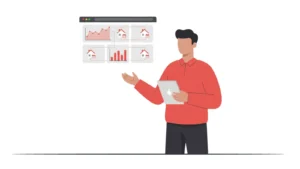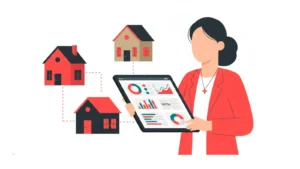Updated : Oct 30, 2024
In this blog, you’ll learn how to use Portfolio Analytics to analyze your booking trends and improve your pricing strategy. You can also compare your listings to the market with Market Dashboards to see how your portfolio compares.
PriceLabs is a comprehensive revenue management platform for vacation rentals and short-term rentals. We are well known for our dynamic pricing solution. However, we also provide market data with our Market Dashboards and a look into your business metrics with Portfolio Analytics.
Portfolio Analytics is our solution for property managers who wish to understand the booking trends of their vacation rentals. This enables them to use the data to come up with an effective pricing strategy and it is FREE!
Table of contents
What is Portfolio Analytics?
With Portfolio Analytics, property managers have a real-time reporting system that surfaces high-level metrics about the business, such as monthly revenue or length of stay information. Executives will find the reporting helpful to get a quick snapshot of their business!
Portfolio Analytics dives further in and exposes listing level performance and metrics, using which property managers can make informed decisions when setting up rate strategy. Want to go a step further and compare your performance against the market? Well, now you can. Portfolio Analytics provides an easy way to compare your prices and occupancy trends against data from a Market Dashboard.
If your PMS is included in the list here, you will be able to access the Portfolio Analytics tool. If you are connected with Airbnb directly, contact us at support@pricelabs.co with the email address you use to log in to PriceLabs. We will activate Portfolio Analytics for your account.


Using Portfolio Analytics
When you first start with Portfolio analytics, you will see general portfolio trends. These will include data regarding the revenue, average length of stay, average lead time, and several reservations your listings received in the last 30 days.


The filters at the top of the page let you select specific segments of your portfolio to analyze.
These filters allow you to:
- Choose one or more PMS.
- Choose one or more groups (Link to the KB questions on how to create groups and tags)
- Filter by tags
- Choose individual listings
- Select listings which are syncing
Deeper Dive Into Various Graphs
Key Performance Indicators
KPI are basic metrics that help you get an overview of what’s going on with your portfolio. You have two parameters that help you assess the data:


- Period Type: This allows you to choose either booking made for your vacation rental or stays that occurred in the last 30 days.
- Compare With: This allows you to select the period against which you’d like to compare your current data. You can choose to compare against the last 30 days or the same period in the previous year. The chart will present you with with the change in the trend with the number on the right side of the last 30 day data.
The data from this can be used to make a rewarding Airbnb pricing strategy to optimize your revenue.
Trends by Stay Date
Four charts will be visible under the Trends by Stay Date section. These charts categorize the trends by revenue, RevPar, Occupancy, and Average Booked Rate.


You can summarize these charts by month, week, day of the year, or day of the week. In addition, these charts let you compare year-over-year metrics easily facilitating Airbnb pricing optimization.
- Use the radio buttons on the top to choose between monthly, weekly, daily, and day of week views
- Use the dropdown on each chart to see metrics other than the four we show by default
- You can click on the years in the legend to hide/show the lines for a year (if you want to declutter the view)
These charts show similar data to the graphs presented under the Market History section in Market Dashboard. In the Market Dashboard, you give us an address and a radius. We pull all of the booking data from all listings in the area and present it to you in easy-to-read charts.
By comparing the charts provided in Portfolio Analytics with Market Dashboard, you can compare the performance of your listing with that of the market. This will be a part of your Airbnb pricing strategy to increase your revenue. For example, if you see a specifically higher booking trend during specific dates, you can consider the reason. You can then adjust your listing rates for future bookings for those particular dates accordingly.
Listing Level Metrics
Listing Level Metrics gives you data in the form of a scatter chart for all your listings. You can use this chart to compare the performance of each listing against one another.
By default, these charts will compare occupancy against revenue. At the top of the chart, you’ll see all the most occupied listings in green. As we move to the right along with the chart, we see which listings produced the most revenue.


You can analyze the data against several different metrics to see what balance of booking trends leads to the highest revenue. Make sure to use filters to compare similar listings for the most accurate results.
- What prices performed the best?
- Analyze the revenue made by each listing against its average booked rate.
- Which listings are getting booked?
- Plot the occupancy of your listings compared with the number of days since last booked.
- Is each listing getting the correct number of bookings?
- Compare the occupancy rate of your listings against the market occupancy.
To analyze the data of specific listings, you can click on the scatter chart and drag your mouse to make a box around the particular listings you are interested in. The system will display the data for the selected listings on the right-hand side.
You can hover over any dot to see more information about each listing. The table below contains all of that info in a sortable format for more data-driven users. When you click the “Review” link in the table, a new tab opens to take you to that listing’s calendar directly. The data provided by this feature would help you to make an effective Airbnb pricing strategy.


Trends by Booking Dates
Trends by Booking Date help you paint a better picture of trends based on when bookings are coming in for future dates. You can analyze the data on a monthly, weekly, daily, and day of the week basis.


The chart helps you to:
- Determine when bookings typically come in and trends related to these bookings.
- Enable you to predict inflows of revenue throughout the year.
- Compare different trends year over year.
The data gathered from these is crucial to plan an Airbnb pricing strategy that will increase your revenue.
LOS and Booking Window Trends
For seasoned revenue managers, the LOS and Booking Window chart is a convenient tool that lets you easily track how many nights get booked from reservations with different booking windows and stay lengths made in the last 30 days.
Instead of looking at total booked nights, you can also see a split by LOS on the Booking Window chart and broken up by Booking Window on the LOS chart. This can help you identify what kind of cascading min-stay settings might be helpful in your area. Do note that your own data will only show reservations you’ve hosted, so there may be two-night bookings in the market even if you don’t accept them.


It is super handy to compare these charts against a Market Dashboard for your area to see if there are any differences that might indicate a revenue opportunity that you might be missing. In case of any discrepancies, you can try adjusting your minimum stay policies or your long-term rates to price your listings more competitively.
LOS and Booking Window Trends helps you to:
- See how far in advance guests are booking and how long they are staying
- Track your trends to the market to see if there are bookings you are missing out on
Rate Shopping and Comparing To Market
This section in Portfolio Analytics allows you to compare the performance of your listing against the market without having to hop back and forth between the Portfolio Analytics and Market Dashboard. Here, you can see the average daily rate of the selected listing along with the occupancy for those listings for all future dates. You can also track your pick-up during the last seven days.


You can look at your listed rates and occupancy for future dates but also overlay them on top of the same data from a Market Dashboard to quickly identify where your prices and occupancy stand against the market. Please note that you do need to be subscribed to a Market Dashboard to be able to use this section of Portfolio Analytics.


By selecting a Market Dashboard, you’ll be able to see comparison data in the given chart showcasing the performance of other listings within our desired radius against your own. You can filter the market data by selecting a relevant bedroom count or any comp-sets you’ve already created in the dropdown on the left.







